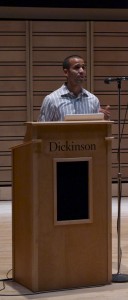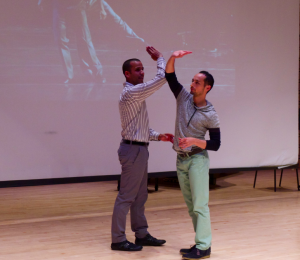In a well attended presentation on Friday April 12 in Rubendall Recital Hall, Alvin Rangel of Tango Vesre, introduced his project and gave a brief overview of modern Argentina’s history, and the evolution of Tango over the last 100 years.
Alvin Rangel, who is currently an associate Professor of Dance at California State University, began working on Tango Vesre, which means “Inverted Tango”, in 2010. From his website, Alvin Rangel describes his project:
“Tango Vesre [Inverted Tango] is a dance performance that through live performance spotlights a 100-year evolution of all-male tango dance in the Buenos Aires of 1910 and 2010. Tango Vesre includes two duets, Parallel Tango by Alejandro Cervera and Bound Tango by Alvin Rangel. Although the work is framed within the Argentinean Tango aesthetics, the performance puts into motion issues of power negotiation, equality, marginalization, gender roles, sexual identity, acceptance, rejection and male dancing bodies.”
Rangel explained how Tango has become one of the most popular forms of dance, known for its “beauty, passion, drama and sexually-charged energy.” The tradition has established a heteronormative culture, where Tango has been branded as strictly a heterosexual dance. Tango has a clear leader and follower, emphasizing the macho Argentine culture, where the man is in control and the woman follows. Rangel wanted to break out of this strict tradition and explore the origins of tango in the slums and lower classes of Buenos Aires, and specifically when men danced with other men.
Rangel discussed his research into the history of tango and reviewed the historiography. He found that there is gaping hole in information on male-male tango practices, even though it began during the formative period in the early twentieth century.
Rangel explains, “the lack of evidence concerning the male partnerships in tango’s literature raised many questions for me as a dance scholar, dancer and choreographer. Therefore, I became interested in analyzing these male partnerships from historic, performative and choreographic perspectives, examining issues of homosexual bonding and sexual identity through tango dance practice.” In context of the discrimination of homosexuals in Argentine society in this early period, Rangel came up with the central question for his project, “Did the all-male tango dance practice enable closeted homosexuals to embody their sexual identity?” He clarifies, “This question I raise does not assume that the male/male partnerships were exclusively a homosexual performance, but rather considers how a homo-social milieu facilitated homosexual bonding.”
In his presentation he explained the origins for the term Tango Vesre – Vesre, means revés or “inverted” in lunfardo, a slang that developed among criminals as code language in prisons and slums. An example of lunfardo would be turning Café, meaning coffee, into feca, tango would become gotán, and hotel –> telo. Vesre was useful in describing how the roles are reversed in queer tango and breaks out of the strict heteronormative structure.
Rangel adopted multiple roles at once in the development of his project. He played the role of choreographer, dancer and scholar, which is quite the feat to pull off. In his presentation, he demonstrated how he developed another form of Tango called “Bounce Tango” which adopts more fluid movements and is not determined by a clear leader or follower.
In the above picture, Alvin works with his partner, Yebel Gallegos and demonstrates how he reinterpreted a classic move used in tango, usually a hooking movement using the legs and he changed it to hooking the arms instead.
For more information, see:
http://alvinrangel.net/Tango_Vesre/HOME.html




Leave a Reply